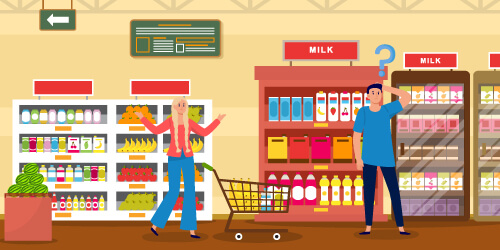There are only a few things more critical to your long-term success than your product assortment. That’s because of what your products* mean to your store. Choose a good variety, and you’re likely to see a steady increase in sales and satisfied customers. Select the wrong assortment, however, and the opposite is true.

Unfortunately, such a mistake can happen. You pick the wrong products, your customers become unhappy, and your reputation and pockets suffer. What compounds this error is when you’re unsure why it’s happening.
That’s where this piece comes in. Below, you’ll find a handful of questions you can ask yourself when selecting your product assortment. And when you do choose which products to stock, it’s best to consider them all.

1. Did you use any data?
There are no two ways around this fact: your retail store is better and healthier when it has access to data. Of course, it depends on the type of data. It also depends on whether or not it's clean or dirty, but that's a point for another day.
In this instance, there are two types to which you need access:
- Point of Sales (POS) data; and
- Market or Syndicated data.
Let's look at POS data first.
Your goal is simple: it's to offer your customers the products they want when they want them. That's where your POS data comes in. By consulting it regularly, you can determine the demand for each product in your assortment across all your categories.
It will also assist you in identifying which items are fast sellers and which are selling poorly. Over and above that, it allows you to allocate the correct amount of space to each product according to their sales. The benefit is you'll end up with a product assortment that works for you rather than against you.
Then there is your market data.
Do you want to turn your retail data into actionable insights that'll allow you to make better business decisions? Book a complimentary consultation with a DotActiv expert today and we can show you how.
This type of data allows you to ensure you what you offer in your store is in line with what customers would find across the market. More than that, it's valuable when you want to see what products sell well in competitor's stores that you don't already stock.
When competing with large retailers with a limited range, you could potentially lose sales of your high-demand items. The only way to bridge this gap is to look at the state of the external market. Also, by spotting these opportunity gaps and taking advantage of them, you can gain leverage over your direct competitors who don't have access to or use this type of data.

2. Did you develop a clustering strategy?
The second question to ask yourself is about your clustering. Did you develop a clustering strategy before selecting your products?
Before we continue, here's a brief definition: “Clustering is the grouping of stores based on similar store and/or demographic characteristics.”

There are two different clustering strategies worth noting: store-based and category-based. You can read more about the different clustering approaches in our infographic here.
Regardless of which strategy you ultimately decide on, if you execute them as expected, you'll get your desired result: to present the right products at the right time to customers.
Of course, there are elements included in the creation of a clustering strategy that you can't ignore. They include, among other elements:
- Store size;
- Store location; and
- Store format.
Your target market is just as important. That's because while you should offer different products across many categories, you must consider who your customer is and what they purchase. The last thing you'd want is to sit with items on the shelf that aren't selling.
That leads to the second reason why you need a strategy.
Clustering makes any ranging exercise easier. Here's why: it gives your category planner a better idea of the products and brands they should include in your assortment to please your customers. Since not all of your stores cater to the same customer, it allows you to tweak your product variety accordingly.
Let's take Hair Products as an example category. For Store/Category Grouping A, most of your customers might purchase Ethnic Hair Care products more regularly than any other hair care product within the category. You'd thus want to open up the range for that grouping in that store.
However, for Store/Category Grouping B, the demand isn't as high so you'd want to reduce the range. That doesn't mean removing the product from your store completely but rather reducing its shelf space. Meanwhile, you could look at opening up on different products that are more suited to the target market for the store.

3. Did you define your assortment planning strategy?
Assortment planning is one of the many critical steps of category management. However, it is also interdependent on all other category management decisions. Any assortment plan you create must consider your business strategy and goals.
That's because once you've chosen your strategy, you can select the merchandising tactics which will help you achieve your goals. We'll touch on merchandising in more detail later in this piece. For now, it's worth pointing out that the tactics you choose must consider the needs of your target customer.
So, what goes into a clear and well-thought-out assortment planning strategy?
Consider your data
As already mentioned, a combination of POS and market data allows you to offer the range of products your customers want and need. You can also look at your loyalty card data if you run an in-store loyalty programme. More than that, the data allows you to evaluate your shelf space and determine the space apportionment for each product.
Consider the size of your category and its congestion ratio
It's critical to consider this both can affect your space apportionment. Your target congestion percentage depends on the size of your products. The larger the product, the higher the congestion percentage can be without your shelf looking messy or overstocked.
Consider your pricing strategy and the products you want to stock
While your products do need to be familiar to your customers, you also need to select those that will offer you the highest possible margin. Of course, there are times when one of your best-selling products may be out of stock.
In that case, you should also include product substitutions within your range. These are products that a customer would happily buy if they find their first choice isn't available.

4. Did you align internally on the role of your category?
Once you know, you must align internally so that everyone in the business knows the role that you're attempting to follow.
Why? It's because the role you choose for your category will affect, among other things:
- Product space allocation;
- Range size;
- Stocking holdings; and
- Margins.
And it won't only affect one category. It'll influence what happens in every category in your store. That means that any wrong move could result in shopper confusion or frustration.

Imagine a customer walking into a store - Store B - and expecting to find the same range of products they found in another of your stores - Store A - only to be disappointed.
Let's say, for example, you've given Category A a Destination role. You would need to give it enough space in-store to show the customer you're the go-to retailer for that product. Your range would also need to match this role, so it would need to be deep. But you'd also need to plan this with other categories in mind.
While you'll not give all of your categories the same role, you still need to position each to satisfy as many, if not all, of your customers' needs.
There is also the point that determining and aligning allows you to decide on the merchandising strategy to help you meet your goals. If you want to give your category a Destination role, you could focus on increasing traffic or defending your market share.

5. Did you build your product hierarchy based on your CDT?
Your consumer decision tree (CDT) - a graphical record of the thought process that any shopper goes through when selecting a product in a category - helps you understand not only the buying behaviour of your customers. It also enables you to anticipate what they'd expect when shopping.
That's why it's critical to your assortment planning actions and when building a product hierarchy.
Of course, before you can build your product hierarchy, you do need to identify your CDT.
Here's how: think like a customer.
In other words, how would you like to shop the category and what aspects do you look at first, second, third and so on? If it's the Cereals category, do you start by looking at the 'Hot' products before moving on to the 'Cold' products? Or, do you focus on price first?
As a side note, because of different consumer behaviours based on cultural, personal and social factors, it's unlikely that you'd only have one CDT per category.
It's also worth analysing your data to see which products sell in the category. This will indicate your shopping trends. More importantly, by looking at your data, you can find out if your consumers are price sensitive, brand loyal or if they purchase small units over bulk items.
With that information at hand, you can begin building your hierarchy. Your hierarchy usually takes the same form as your CDT but stops at your sub-category.
Building your hierarchy based on your CDT will also assist you to choose whether or not to place your products according to price or brand, for example.
A final point is that you also need to plan your merchandising strategies based on your CDT. Ideally, when choosing your merchandising strategy, it should be done to enforce your CDT.
For example, when you have brand-loyal customers who buy yoghurt, you should consider brand blocking first and then split your tubs by size and variant.

Conclusion
Are you looking to get serious about offering the right product assortment to your target market? Then it’s time to consider investing in specialist assortment planning software or world-class assortment optimization services.
Besides helping you select the right products, either can help you to place them correctly on the shelf to drive increased profitability. Book a custom complimentary consultation with a DotActiv expert today or browse through our various services and software editions on our online store.
*This article was updated on 6 October 2022.


